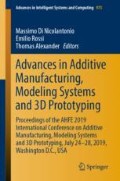Abstract
The research investigates experimental digital models, used to enhance the educational methodology, concerning the fundamentals of graphic representation, especially in the general sense of perspective models. In this experimentation, we examine the high communicative efficacy of a generative parametric interactive models, constructed on the basis of visual nodal programming, which: on one hand makes it possible to explain in graphic form the hierarchical and temporal relation of geometrical operations and projective on which the representation is based; on the other hand it allows to experiment the parametric dynamic models, in order to appropriate the perceptual changes that arise from the projective variations that can be established between the geometrical entities present in the models. A possibility, this dynamic interaction, which has not yet been sufficiently experienced and that deserves attention and research.
Access this chapter
Tax calculation will be finalised at checkout
Purchases are for personal use only
References
Fasolo, M.: Sul modello. In: Migliari, R.: Disegno come Modello. Edizioni Kappa, Roma (2004)
Fiedler, G.: Trattato di geometria descrittiva. Successori le Monnier, Firenze (1874)
Migliari, R.: Disegnare nello spazio. In: Disegnare, idee e immagini, n. 38, p. 25. Gangemi Editore, Roma (2009)
Vagnetti, L.: De naturali et artificiali perspectiva. L.E.F., Firenze (1979)
Kemp, M.: La scienza dell’arte. Prospettiva e percezione visiva da Brunelleschi a Seurat. Giunti Editore, Firenze (1994)
Migliari, M.: Disegno come Modello. Edizioni Kappa, Roma (2004)
Fasolo, O.: Un modo nuovo ma antico di fare e di insegnare la prospettiva. Note di cronaca e storia delle applicazioni della geometria descrittiva ai problemi della rappresentazione. In: Quaderni di Applicazioni della Geometria Descrittiva, n. 3. Edizioni Kappa, Roma (1984)
Gorjanc, S., Jurkin, E.: Web textbook for descriptive geometry. In: MoNGeometrija, Novi Sad, Serbia (2018). ISBN 978-86-6022-055-6
Teixeira, F.G., Dos Santos, S.L.: Hypercal3D: a computer application to support the teaching and learning of descriptive geometry. In: 16th International Conference on Geometry and Graphics (2014)
Di Paola, F., Pedone, P., Pizzurro, M.R.: Digital and interactive learning and teaching methods in descriptive Geometry. Procedia Soc. Behav. Sci. 106, 873–885 (2013)
Valenti, G.M.: La rappresentazione digitale del chiaroscuro. In: Migliari, R. Geometria Descrittiva. De Agostini Squola, Torino (2009)
Acknowledgments
The authors have common methodology and contents of the research. In particular, Marco Fasolo and Graziano Mario Valenti, have developed the need to develop applications on digital models. Marco Fasolo deepened the critical-historical survey on the use of models in the illustration of the principles of descriptive geometry and identified the typical characteristic operations of teaching. Graziano Mario Valenti has designed and developed the generative, parametric digital model and the related modes of interaction. Flavia Camagni has dealt with documentary research and model testing.
From a strictly editorial point of view, Marco Fasolo edited the paragraph entitled “The model as icon of representation”. Graziano Mario Valenti edited the paragraph “Introduction”, “The generative model, parametric, interactive”, “Conclusions”.
Flavia Camagni edited the paragraph “Examples”.
Author information
Authors and Affiliations
Corresponding author
Editor information
Editors and Affiliations
Rights and permissions
Copyright information
© 2020 Springer Nature Switzerland AG
About this paper
Cite this paper
Fasolo, M., Valenti, G.M., Camagni, F. (2020). Generative Models for Experimentation and Knowledge of Perspective Principles. In: Di Nicolantonio, M., Rossi, E., Alexander, T. (eds) Advances in Additive Manufacturing, Modeling Systems and 3D Prototyping. AHFE 2019. Advances in Intelligent Systems and Computing, vol 975. Springer, Cham. https://doi.org/10.1007/978-3-030-20216-3_25
Download citation
DOI: https://doi.org/10.1007/978-3-030-20216-3_25
Published:
Publisher Name: Springer, Cham
Print ISBN: 978-3-030-20215-6
Online ISBN: 978-3-030-20216-3
eBook Packages: EngineeringEngineering (R0)

